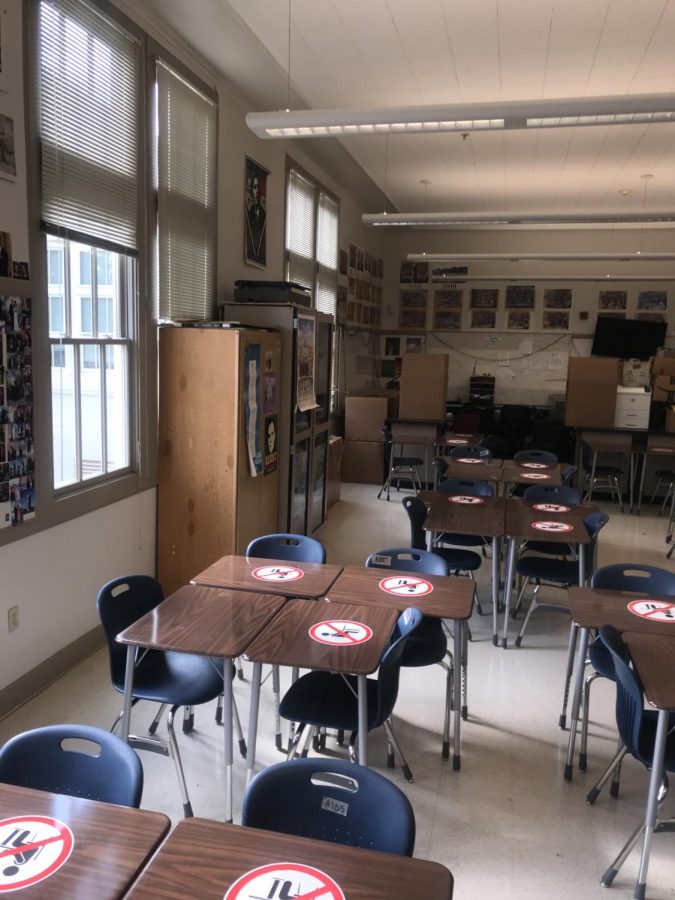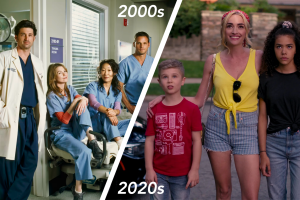Existing A Building ventilation concerns exacerbated by return to school
On a hot day, rooms that lack air conditioning, like A105, quickly become overheated due to the poor ventilation, an issue that has become increasingly worrisome for teachers who will soon return to teaching in person.
March 9, 2021
As the San Mateo Union High School District (SMUHSD) plans to reopen schools, with the first phase of reopening beginning this Wednesday, concerns are mounting among teachers in the A Building regarding the quality of ventilation.
Each year, as the weather grows warmer, teachers and students in the A Building suffer due to the lack of air conditioning which creates high indoor temperatures, making it difficult for them to stay alert and be on task. With the exception of the A Building, HVAC systems have been installed in all buildings on campus as they have been remodeled and all other buildings meet the guidelines set forth in the memorandum of understanding (MOU). However, the 98-year-old A Building, which was last renovated in 2005, has three different ventilation systems, some of which fail to meet the requirements of the MOU. The rooms with the most ventilation have air intake and exhaust in the form of air handlers and mechanical exhaust and a select few have air conditioning in addition to the ventilation system. Nine rooms — A103, A113, A115, A127, A144, A129, A201, A203, A211 — have air intake in the form of air handlers but no exhaust, meaning the air is stagnant.
English teacher Marina Junqueira, who teaches in room A103, had a student pass out from the heat two years ago and now monitors the temperature inside her classroom with a thermometer, observing that the temperature indoors is at times hotter than outdoors. Junqueira is worried about her ability to teach in a safely ventilated room and also find ways to keep her students cool when school reopens.
“That’s what’s keeping me up. I can come up with places for us to go and be comfortable, I just don’t know if I will be able to teach because of internet connection,” Junqueria said.
SMUHSD has purchased HEPA air scrubbers which will clean the air in Junqueria’s room — and the eight others without exhaust — allowing the rooms to meet the guidelines set forth in the MOU and by the Centers for Disease Control and Prevention. The addition of HEPA filters is a temporary, albeit a safe fix for the larger issue of a poorly ventilated learning environment. In a recent Board meeting, SMUHSD approved a plan to add a full HVAC system to the A Building, but this will not be accomplished until the summer of 2022.
“The HEPA filters help us meet the expectations but they are loud and they don’t provide any air cooling,” principal Paul Belzer said. “I think at a certain point there is probably a value-add, if you will, that if you’re going to do so much work, you might as well do all the work.”
Despite the added safety that the HEPA filters will bring, history teacher Annie Miller, who teaches in A127, also worries about adequate air circulation in her classroom. While the temperature has been a cause of concern for Miller, she has been more worried about the quality of air, a concern which the pandemic has exacerbated.
“After a warm day — at the end of the day — I can feel, you know, I can’t think as clearly, and I walk out into the hallway or I walk outside and I take a deep breath and there’s a noticeable difference in the ability to breathe,” Miller said.
Health aide Ana Herold, who works in the Health Office in A140 — a room which lacks an air cooling system — shares similar sentiments to Miller about her concern regarding the ventilation and her students’ well being, prior to and during the pandemic. Herold has seen students following PE classes and rallies who are overheated and need a space to cool down, a need that the health office is unable to fulfill.
“I would like [air conditioning] for the students in general, Covid or no Covid. Sometimes it just gets really warm and [students] come in, they’re beet red, they’re sweaty. We need them to cool their bodies down as quickly as possible,” Herold said. “If they’re coming into a warm room on top of that, it really doesn’t help.”
When school reopens, Herold will be working in A144, another room without an exhaust system, which will serve as an isolation room for students who begin to exhibit symptoms of COVID-19 while at school.
When Miller returns to in-person teaching she plans to keep the windows in her classroom open, but she still has doubts about safety.
“I wouldn’t send my own children into that room,” Miller said. “It’s still a 98-year-old building with 12 people, 13 people in a room together before the end of the pandemic… It’s not that we don’t want to return. We just want to keep you safe.”
Although Miller and several other teachers have been vaccinated, she feels that the end of the pandemic is in sight and doesn’t want students to jeopardize their health in a rush to return.
“When we get back into these rooms in the midst of a warm spring, and everybody’s masked or double-masked, and we’re not actually interacting with each other in the way that we would like to,” Miller said. “I don’t think that that’s going to be a quick fix for anyone’s mental health or anyone feeling better, and I think that the air quality is just going to add to the stress.”
Upon reopening, SMUHSD plans to take all safety precautions, including the purchase of CO2 monitors to ensure air is properly ventilated. Teachers will also be encouraged to keep their windows open and will have the option to use air purifiers for their comfort.
“We are committed to making certain that the A Building ventilation is safe for students and staff [with] the additional HEPA filters and air conditioning — there will be some sound with those pieces, but we do anticipate being prepared to open safely when we are allowed to, when we’re in the orange tier,” Belzer said.










































